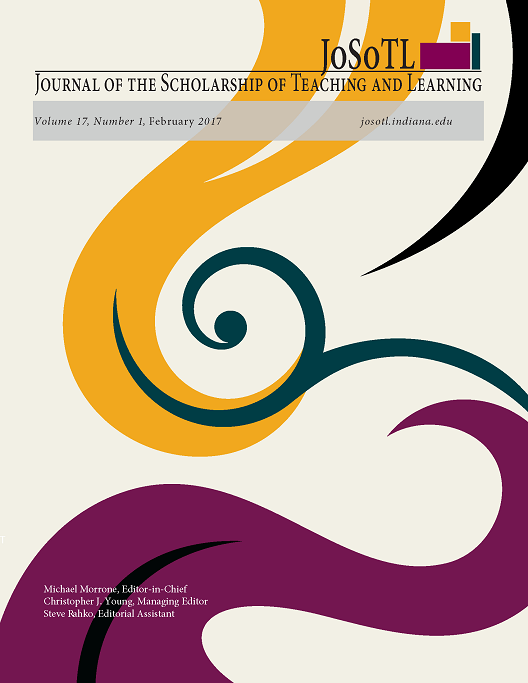Does it Matter if Students Have the Same Instructor for Both Lecture and Lab Sections? An Analysis of Introductory Biology Students
Main Article Content
Abstract
Downloads
Article Details
- Authors retain copyright and grant the Journal of the Scholarship of Teaching and Learning (JoSoTL) right of first publication with the work simultaneously licensed under a Creative Commons Attribution License, (CC-BY) 4.0 International, allowing others to share the work with proper acknowledgement and citation of the work's authorship and initial publication in the Journal of the Scholarship of Teaching and Learning.
- Authors are able to enter separate, additional contractual agreements for the non-exclusive distribution of the journal's published version of the work (e.g., post it to an institutional repository or publish it in a book), with an acknowledgement of its initial publication in the Journal of the Scholarship of Teaching and Learning.
- In pursuit of manuscripts of the highest quality, multiple opportunities for mentoring, and greater reach and citation of JoSoTL publications, JoSoTL encourages authors to share their drafts to seek feedback from relevant communities unless the manuscript is already under review or in the publication queue after being accepted. In other words, to be eligible for publication in JoSoTL, manuscripts should not be shared publicly (e.g., online), while under review (after being initially submitted, or after being revised and resubmitted for reconsideration), or upon notice of acceptance and before publication. Once published, authors are strongly encouraged to share the published version widely, with an acknowledgement of its initial publication in the Journal of the Scholarship of Teaching and Learning.
References
Allen, D., & Tanner, K. (2005). Infusing active learning into the large-enrollment biology class: seven strategies, from the simple to complex. Cell Biology Education, 4, 262-268. http://dx.doi.org/10.1187/cbe.05-08-0113.
Baldwin, R. G., & Wawrzynski, M. R. (2011). Contingent faculty as teachers: what we know; what we need to know. American Behavioral Scientist, 55(11), 1485-1509. http://dx.doi.org/10.1177/0002764211409194.
Beichner, R. J., & Saul, J. M. (2003). Introduction to the SCALE-UP (student-centered activities for large enrollment undergraduate programs) project. Paper presented at the Proceedings of the International School of Physics, Varenna, Italy. http://www.ncsu.edu/PER/Articles/Varenna_SCALEUP_Paper.pdf.
Benjamin, E. (2002). How over-reliance on contingent appointments diminishes faculty involvement in student learning. Peer Review, 5, 4-10. http://www.aacu.org/publicationsresearch/periodicals/how-over-reliance-contingent-appointments-diminishes-faculty.
Burrowes, P. A., & Nazario, G. M. (2008). Promoting student learning through the integration of lab and lecture: The seamless biology curriculum. Journal of College Science Teaching, 37(4), 18-23. http://www.nsta.org/publications/browse_journals.aspx?action=issue&id=10.2505/3/jcst08_037_ 04.
Gonzalez, B. Y. (2014). A six-year review of student success in a biology course using lecture, blended, and hybrid methods. Journal of College Science Teaching, 43(6), 14-19.
Hoellwarth, C., Moelter, M. J., & Knight, R. D. (2005). A direct comparison of conceptual learning and problem solving ability in traditional and studio style classrooms. American Journal of Physics, 73(5), 459-462. DOI: 10.1119/1.1862633.
Kendall, K. D., & Schussler, E. E. (2012). Does instructor type matter? Undergraduate student perception of graduate teaching assistants and professors. CBE Life Sciences Education, 11, 187-199. http://dx.doi.org/10.1187/cbe.11-10-0091
Kendall, K. D., & Schussler, E. E. (2014). The effect of instructor title on student instructional expectations. International Journal for the Scholarship of Teaching and Learning, 8(1), Article 10. http://digitalcommons.georgiasouthern.edu/ijsotl/vol8/iss1/10/?utm_source=digitalcommons.georgiasouthern.edu%2Fijsotl%2Fvol8%2Fiss1%2F10&utm_medium=PDF&utm_campaign=PDFCoverPages
Kezar, A., Maxey, D., & Eaton, J. (2014). An examination of the changing faculty: Ensuring institutional quality and achieving desired learning outcomes CHEA Occasional Paper. Washington, DC: Institute for Research and Study of Accreditation and Quality Assurance. http://www.chea.org/pdf/Examination_Changing_Faculty_2013.pdf
Klionsky, D. J. (2004). Talking biology: learning outside the book--and the lecture. Cell Biology Education, 3, 204-210.
Knight, J. K., & Wood, W. B. (2005). Teaching more by lecturing less. Cell Biology Education, 4, 298-310. http://dx.doi.org/10.1187/05-06-0082.
Krontiris-Litowitz, J. (2009). Articulating scientific reasoning improves student learning in an undergraduate anatomy and physiology course. CBE Life Sciences Education, 8, 309-315. DOI: 10.1187/cbe.08-11-0066.
LeFebvre, L., & Allen, M. (2014). Teacher immediacy and student learning: an examination of lecture/laboratory and self-contained course sections. Journal of the Scholarship of Teaching and Learning, 14(2), 29-45. http://eric.ed.gov/?id=EJ1034599.
Lents, N. H., & Cifuentes, O. E. (2009). Web-based learning enhancements: video lectures through voice-over PowerPoint in a majors-level biology course. Journal of College Science Teaching, 39(2), 38-46.
Lodish, H. F., & Rodriguez, R. K. (2004). A combination of lectures, problem sets, and recitation sections is an excellent way to teach undergraduate cell biology at a high level. Cell Biology Education, 3, 202-204.
Lumpkin, A., Achen, R. M., & Dodd, R. K. (2015). Student perceptions of active learning. College Student Journal, 49(1), 121-133.
Sundberg, M. D., Armstrong, J. E., & Wischusen, E. W. (2005). A reappraisal of the status of introductory biology laboratory education in U.S colleges & universities. The American Biology Teacher, 67(9), 525-529. DOI: 10.1662/0002-7685(2005)067[0525:AROTSO]2.0.CO;2.
Todd, T. S., Tillson, L. D., Cox, S. A., & Malinauskas, B. K. (2000). Assessing the perceived effectiveness of the basic communication course: an examination of the mass-lecture format versus the self-contained format. Journal of the Association for Communication Administration, 29, 185-195. http://eric.ed.gov/?id=EJ622770.
Umbach, P. D. (2007). How effective are they? Exploring the impact of contingent faculty on undergraduate education. The Review of Higher Education, 30(2), 91-123. http://eric.ed.gov/?id=EJ754257.
Wildermuth, S. M., French, T., & Fredrick, E. (2013). Finding the right fit: Assessing the impact of traditional v. large lecture/small lab course formats on a general education course. International Journal for the Scholarship of Teaching and Learning, 7(1), 1-21. http://digitalcommons.georgiasouthern.edu/ij-sotl/vol7/iss1/6.
